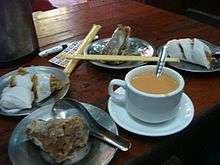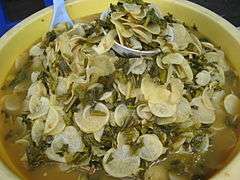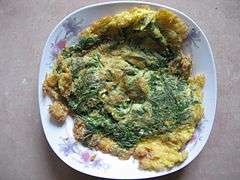Burmese cuisine
Burmese cuisine[1] is mainly an amalgam of cuisines from various regions of Myanmar. It has also been influenced by various cuisines of neighbouring countries, in particular, China, India and Thailand.
| Part of a series on the |
| Culture of Myanmar |
|---|
 |
| People |
|
Mythology and folklore |
|
Cuisine
|
|
Literature
|
|
Media |
|
Monuments
|
|
Organisations
|
Modern Burmese cuisine comes in two general varieties: coastal and inland. The cuisine in the coastal areas, such as that in the main city Yangon, makes extensive use of fish and seafood-based products like fish sauce and ngapi (fermented seafood). The cuisine in inland regions, such as Upper Myanmar and hill regions, tends to use more meat and poultry although modern inland cooking too has incorporated freshwater fish and shrimp as a source of protein in several ways: fresh, salted whole or filleted, salted and dried, made into a salty paste, or fermented sour and pressed.
Burmese cuisine also includes a variety of salads (a thoke), centred on one major ingredient, ranging from starches like rice, wheat and rice noodles, glass noodles and vermicelli, to potato, ginger, tomato, kaffir lime, long bean, lahpet (pickled tea leaves), and ngapi (fish paste). These salads have always been popular as fast foods in Burmese cities. Mohinga is the traditional breakfast dish and is Burma's national dish.
A popular Burmese rhyme sums up the traditional favourites: "A thee ma, thayet; a thar ma, wet; a ywet ma, lahpet" (အသီးမှာသရက်၊ အသားမှာဝက်၊ အရွက်မှာလက်ဖက်။), meaning: "Of all the fruit, the mango's the best; of all the meat, the pork's the best; and of all the leaves, lahpet's the best".
Eating customs



Traditionally, Burmese eat their meals from dishes on a low table, while sitting on a bamboo mat.[2] Dishes are served simultaneously.[2] A typical meal includes steamed rice as the main dish and accompanying dishes called hin, including a curried freshwater fish or dried/salted fish dish, a curried meat or poultry dish instead, a light soup called hin gyo (ဟင်းချို), called chinyay hin (ချဉ်ရည်ဟင်း) if sour, and fresh or boiled vegetables to go with a salty dish, almost invariably a curried sauce of pickled fish (ngapi yayjo) in Lower Burma. Fritters such as gourd or onions in batter as well as fish or dried tofu crackers are extra.
Out of respect, the eldest diners are always served first before the rest join in; even when the elders are absent, the first morsel of rice from the pot is scooped and put aside as an act of respect to one's parents, a custom known as u cha (ဦးချ, lit. first serve).[3]
The Burmese eat with their right hand, forming the rice into a small ball with only the fingertips and mixing this with various morsels before popping it into their mouths.[3] Chopsticks and Chinese-style spoons are used for noodle dishes, although noodle salads are more likely to be eaten with just a spoon. Knives and forks are used rarely in homes but will always be provided for guests and are available in restaurants and hotels. Drinks are not often served with the meal and, instead, the usual liquid accompaniment is in the form of a light broth or consommé served from a communal bowl. Outside of the meal, the Burmese beverage of choice is light green tea, yay nway gyan (ရေနွေးကြမ်း).
Food theories
In traditional Burmese medicine, foods are divided into two classes: heating (အပူစာ, apu za) or cooling (အအေးစာ, a-aye za), based on their effects on one's body system, similar to the Chinese classification of food.[3]
Examples of heating and cooling foods include:
- Heating foods:
- chicken
- bitter melon
- durian
- mango
- chocolate
- ice cream
- Cooling foods:
- pork
- eggplant
- dairy products
- cucumbers
- radish
The Burmese also hold several taboos and superstitions regarding consumption during various occasions in one's life, especially pregnancy. For instance, pregnant women are not supposed to eat chili, due to the belief that it causes children to have sparse scalp hairs.[3]
Influences

The country's diverse religious makeup influences its cuisine, as Buddhists avoid beef and Muslims pork. Beef is considered taboo by devout Buddhists because the cow is highly regarded as a beast of burden.[4] Vegetarian dishes are only common during the Buddhist Lent (ဝါတွင်း), a three-month Rains Retreat, as well as Uposatha days. During this time, only two meals (i.e. breakfast and lunch) are consumed before midday to observe the fasting rules (Uposatha) and abstinence from meat (သက်သတ်လွတ်, lit. 'free of killing') is observed by devout Buddhists. Throughout the rest of the year, many foods can be prepared vegetarian on request, but the bulk of Burmese food is prepared with fish or meat broth bases. Also, many of the several ethnic groups prepare at least one inherently vegetarian dish (notably cuisine from the Shan people).
The countries that border Myanmar, especially India, China and Thailand, have influenced Burmese cuisine.[5] Indian influences are found in Burmese versions of dishes such as samosas and biryani, and Indian curries, spices and breads such as naan and paratha. Southern Indian, especially Chettiar (ချစ်တီးကုလား) cuisine is also popular in cities. Chinese influences in Burmese cuisine are shown in the use of ingredients like bean curd and soya sauce, various noodles as well as in stir frying techniques. As in neighbouring Thailand and Laos, fried insects are eaten as snacks.
Southern Myanmar, particularly the area around Mawlamyine is known for its cuisine, as the Burmese proverb goes: "Mandalay for eloquence, Mawlamyine for food, Yangon for boasting" (မန္တလေးစကား ရန်ကုန်အကြွား မော်လမြိုင်အစား).[6]
Preparation
Burmese dishes are not cooked with precise recipes. The use and portion of ingredients used may vary, but the precision of timing is of utmost importance.[3][7] One of the few remaining pre-colonial cookbooks is the Sadawset Kyan (စားတော်ဆက်ကျမ်း, lit. Treatise on Royal Foods), written on palm leaves in 1866 during the Konbaung dynasty.[7]
Depending on the dish at hand, it may be roasted, stewed, boiled, fried, steamed, baked or grilled, or any combination of the said techniques.[7] Burmese curries use only a handful of spices (in comparison to Indian ones) and use more garlic and ginger.[7] Dishes are prepared with plenty of oil in the case of curries and soups, and the level of spices and herbs varies depending on the region; Kachin and Shan curries will often use more fresh herbs.[8]
Ingredients
Ingredients used in Burmese dishes are often fresh. Many fruits are used in conjunction with vegetables in many dishes. The Burmese eat a great variety of vegetables and fruits, and all kinds of meat. A very popular vegetable is jengkol (တညင်းသီး), which is usually boiled or roasted and dipped in salt, oil and sometimes, cooked coconut fat.
Starches
The most common starch (staple food) in Myanmar is white rice or htamin (ထမင်း), which is served with accompanying meat dishes called hin (ဟင်း). Consumers in the northern highlands (e.g., Shan State) prefer stickier lower-amylose varieties like kauk hnyin (ကောက်ညှင်း; glutinous rice) and kauk sei, while consumers in lower delta regions preferring higher-amylose varieties like kauk chaw and kauk kyan.[9] Lower-amylose rice varieties are commonly used in Burmese snacks (mont).[9]
Paw hsan hmwe (ပေါ်ဆန်းမွှေး), a fragrant aromatic rice, is the most popular rice used in Burma and is rated as high as Thai jasmine rice or basmati rice. Today, Myanmar is the world's sixth largest producer of rice, though in recent times less is exported and even domestic supplies cannot be guaranteed.[10] A purple variety of kauk hnyin, known as nga cheik (ငချိပ်), is commonly a breakfast dish.
Various types of noodles, ranging from egg and wheat noodles to rice vermicelli, are also used in salads and soups. Typically, vermicelli noodles and rice noodles are often used in soups, while thick rice and wheat noodles are used in salads. Palata (ပလာတာ), a flaky fried flatbread related to Indian paratha, is often eaten with curried meats while nan bya (နံပြား), a baked flatbread is eaten with any Indian dishes. Another favourite is aloo poori (အာလူးပူရီ), puffed-up fried breads eaten with potato curry.
Ngapi
Ngapi (ငါးပိ), a paste made from salted, fermented fish or shrimp, is considered the cornerstone of any Burmese traditional meal. It is used as a main ingredient in soup base, salads, main dishes, condiments, and plainly with cooked rice as well. Different usage for various dish depends on the region.
The ngapi of Rakhine State contains no or little salt, and uses marine fish. It is used as a soup base for the Rakhine regional cuisine, mont di (မုန့်တီ). It is also used widely in cooking vegetables, fish and meat.
In the coastal Ayeyarwady and Tanintharyi divisions, the majority of ngapi is based on fresh and salty fish. Ngapi is also used as a condiment such as ngapi yay (ငါးပိရည်), an essential part of Karen cuisine, which includes runny ngapi, spices and boiled fresh vegetables. The upper part of Myanmar which is the Shan State does not eat ngapi at all, instead they use fermented beans or fermented bean curd for their dishes and cuisines. Although some natives families from the lower part of Myanmar who settled in the upper parts still eat ngapi as their tradition.
Condiments
Burmese cuisine is full of condiments, from sweet, sour to savoury. The most popular are pickled mango, balachaung (shrimp and ngapi floss) and ngapi gyaw (fried ngapi) and preserved vegetables in rice wine (from Shan State). Ngapi plays a major part in condiments, as a dip for fresh vegetables.
Fermented beans, called pè ngapi, from the Shan State plays a major role in Shan cuisine. Dried bean ngapi chips are used as condiments for various Shan dishes.
Another bean-based condiment popular amongst the Bamar and the central dry region is pon ye gyi (ပုံးရည်ကြီး) - a thick salty black paste made from fermented soy beans. It is used in cooking, especially pork, and as a salad, with ground nut oil, chopped onions and red chili. Bagan is an important producer of pon ye gyi.
Fruits
Myanmar has a wide range of fruits, and most are of tropical origin. However, some notable Western fruits such as strawberries are also popular. Durian, guava, and other fruits are commonly served as desserts. Other fruits include mango, banana, jackfruit, plum, lychee, papaya, pomelo, water melon, pomegranate, mangosteen, sugar-apple and rambutan.
Notable dishes
Because a standardised system of romanisation for spoken Burmese does not exist, pronunciations of the following dishes in modern standard Burmese approximated using IPA are provided (see IPA/Burmese for details).
- Gyin thohk (ချင်းသုပ် [dʒɪ́ɰ̃ θoʊʔ]), ginger salad with sesame seeds
- Khauk swè thoke (ခေါက်ဆွဲသုပ် [kʰaʊʔsʰwɛ́ θoʊʔ]), wheat noodle salad with dried shrimps, shredded cabbage and carrots, dressed with fried peanut oil, fish sauce and lime
- Kat kyi kaik (ကတ်ကြေးကိုက် [kaʔtɕígaɪʔ]), lit. 'cut with scissors'), a southern coastal dish (from the Dawei area) of rice noodles with a variety of seafood, land meats, raw bean sprouts, beans and fried eggs, comparable to pad thai
- Let thohk sohn (လက်သုပ်စုံ [lɛʔ θoʊʔsòʊɴ]), similar to htamin thohk with shredded green papaya, shredded carrot, ogonori sea moss and often wheat noodles
- Mohinga (မုန့်ဟင်းခါး [mo̰ʊɴhíɰ̃ɡá]), the unofficial national dish of rice vermicelli in fish broth with onions, garlic, ginger, lemon grass and sliced tender core of banana-stem, served with boiled eggs, fried fish cake (nga hpe) and fritters (akyaw).
- Mont let saung (မုန့်လက်ဆောင်း [mo̰ʊɴlɛʔsʰáʊɴ]), tapioca balls, glutinous rice, grated coconut and toasted sesame with jaggery syrup in coconut milk
- Nan gyi thohk (နန်းကြီးသုပ် [náɰ̃dʒí θoʊʔ]) or Mont di, thick rice noodle salad with chickpea flour, chicken, fish cake (nga hpe), onions, coriander, spring onions, crushed dried chilli, dressed with fried crispy onion oil, fish sauce and lime
- Ohn-no khao swè (အုန်းနို့ခေါက်ဆွဲ [ʔóʊɴno̰ kʰaʊʔsʰwɛ́]), curried chicken and wheat noodles in a coconut milk broth similar to Malaysian laksa and Chiang Mai's khao soi
- Sanwin makin (ဆနွင်းမကင်း [sʰànwɪ́ɴ məkɪ́ɴ]), semolina cake with raisins, walnuts and poppy seeds
- Shwe gyi mohnt (ရွှေကြည်မုန့် [ʃwè dʒì mo̰ʊɴ]), hardened semolina (wheat) porridge with poppy seeds
- Shwe yin aye (ရွှေရင်အေး [ʃwè jɪ̀ɴ ʔé]), agar jelly, tapioca and sago in coconut milk
- Nga thalaut paung(ငါးသလောက်ပေါင်း [ŋəθəlaʊʔbáʊɴ]), a freshwater fish stewed in vinegar, soy sauce, tomatoes, and lemongrass
- Pon ye gyi (ပုံးရည်ကြီး [póʊɴjèd͡ʑí]), a fermented bean condiment commonly cooked with pork or chicken
Chinese-inspired

- A sein kyaw (အစိမ်းကြော် [ʔəséɪɴdʒɔ̀]), cabbage, cauliflower, carrot, green beans, baby corn, cornflour or tapioca starch, tomatoes, squid sauce
- Hpet htohk (lit. leaf wrap) (ဖက်ထုပ် [pʰɛʔtʰoʊʔ]), meat, pastry paper, ginger, garlic, pepper powder, and salt. Usually served with soup or noodles.
- Kyay oh (ကြေးအိုး [tʃé ʔó]), vermicelli noodles in soup with pork offal and greens
- Htamin jaw (ထမင်းကြော် [tʰəmɪ́ɴ dʒɔ̀]), fried rice with boiled peas (pè byouk), the poor man's favourite breakfast, sometimes with meat, sausage, and eggs.
- Kawyei khao swè (ကော်ရည်ခေါက်ဆွဲ [kɔ̀ jè kʰaʊʔ sʰwɛ́]), noodles and curried duck (or pork) in broth with eggs. Also known as lor mee in Singapore and Malaysia.
- Mi swan (မြူစွမ် [mjù swàɴ]), very soft rice noodles, known as misua in Singapore and Malaysia. It is a popular option for invalids, usually with chicken broth.
- Panthay khao swè (ပန်းသေးခေါက်ဆွဲ [páɴðé kʰaʊʔ sʰwɛ́]), halal noodles with chicken and spices, often served by the Muslim Panthay Chinese.
- San byohk (ဆန်ပြုတ် [sʰàɴbjoʊʔ]), rice congee with fish, chicken or duck often fed to invalids.
- Sigyet khauk swè (ဆီချက်ခေါက်ဆွဲ [sʰìdʒɛʔ kʰaʊʔ sʰwɛ́]), wheat noodles with duck or pork, fried garlic oil, soy sauce and chopped spring onions. It is considered an 'identity dish' of Myanmar and Burmese Chinese.
- Wet tha dote htoe (ဝက်သားတုတ်ထိုး [wɛʔθádoʊʔtʰó]), pork offal cooked in light soy sauce. Eaten with raw ginger and chili sauce.
Indian-inspired

- Danbauk (ဒံပေါက် [dàɴbaʊʔ], from Persian dum pukht), Burmese-style biryani with either chicken or mutton served with mango pickle, fresh mint and green chili
- Fried chapati, crispy and blistered, with boiled peas (pé-byohk), a popular breakfast next to nan bya
- Halawa (ဟလဝါ [hàləwà]), a snack made of sticky rice, butter, coconut milk, from Indian dessert halwa. In Burma halwa is referred to a loose form, something like smashed potato, without baking into a hard or firmer cake in contrast to Sa-Nwin-Ma-Kin.
- Hpaluda (ဖာလူဒါ [pʰàlùdà]), similar to the Indian dessert falooda, rose water, milk, jello, coconut jelly, coconut shavings, sometimes served with custard and ice cream
- Htat taya (ထပ်တစ်ရာ [tʰaʔ təjà]), lit. "a hundred layers", fried flaky multi-layered paratha with either a sprinkle of sugar or pè byouk
- Htawbat htamin (ထောပတ်ထမင်း [tʰɔ́baʔtʰəmɪ́ɴ]), rice made with butter and mostly eaten with chicken curry
- Malaing lohn (မလိုင်လုံး [məlàɪɴ lóʊɴ]), Burmese-style gulab jamun
- Nan bya (နံပြား [nàɴbjá]), Burmese-style naan buttered or with pè byouk, also with mutton soup
- Palata (ပလာတာ [pəlàtà]), Burmese-style paratha with egg or mutton
- Samusa (စမူဆာ [səmùsʰà]), Burmese-style samosa with mutton and onions served with fresh mint, green chilli, onions and lime
- Samusa thohk (စမူဆာသုပ် [səmùsʰà θoʊʔ]), samosa salad with onions, cabbage, fresh mint, potato curry, masala, chili powder, salt and lime
- Theezohn chinyay (သီးစုံချဉ်ရည် [θízòʊɴtʃìɴjè]), lit. vegetable all-sorts sour broth, with drumstick, lady's finger, eggplant, green beans, potato, onions, ginger, dried chilli, boiled egg, dried salted fish, fish paste and tamarind
Shan-inspired

- Htamin jin (ထမင်းချဉ် [tʰəmíɴdʒɪ̀ɴ]), a rice, tomato and potato or fish salad kneaded into round balls dressed and garnished with crisp fried onion in oil, tamarind sauce, coriander and spring onions often with garlic, Chinese chives or roots (ju myit), fried whole dried chili, grilled dried fermented bean cakes (pé bouk) and fried dried tofu (topu jauk kyaw) on the side
- Khow suey (ခေါက်ဆွဲ), a one-dish soup meal made of egg noodles and curried beef or chicken with coconut milk, served with a variety of contrasting condiments
- Lahpet thohk (လက်ဖက်သုပ် [ləpʰɛʔ θoʊʔ]), a salad of pickled tea leaves with fried peas, peanuts and garlic, toasted sesame, fresh garlic, tomato, green chili, crushed dried shrimps, preserved ginger and dressed with peanut oil, fish sauce and lime
- Meeshay (မြီးရှေ [mjíʃè]), rice noodles with pork or chicken, bean sprouts, rice flour gel, rice flour fritters, dressed with soy sauce, salted soybean, rice vinegar, fried peanut oil, chilli oil, and garnished with crisp fried onions, crushed garlic, coriander, and pickled white radish/mustard greens
- Papaya salad (သင်္ဘောသီးသုပ် [θíɴ bɔ́ ðí θoʊʔ])
- Shan tohu (ရှမ်းတိုဟူး [ʃáɴ tòhú]), a type of tofu made from chickpea flour or yellow split pea eaten as fritters (tohpu jaw) or in a salad (tohpu thohk), also eaten hot before it sets as tohu byawk aka tohu nway and as fried dried tohpu (tohu jauk kyaw)
- Shan khao swé (ရှမ်းခေါက်ဆွဲ [ʃáɴ kʰaʊʔsʰwɛ́]), rice noodles with chicken or minced pork, onions, garlic, tomatoes, chili, crushed roasted peanuts, young vine of mangetout, served with tohu jaw or tohu nway and pickled mustard greens (monnyinjin)
- Wet tha chin (ဝက်သားချဉ် [wɛʔ θətʃʰɪ̀ɴ]), preserved minced pork in rice
- Wet tha hmyit chin (ဝက်သားမျှစ်ချဉ် [wɛʔ θá m̥jɪʔ tʃʰɪ̀ɴ]), pork with pickled bamboo shoots
– Source:[11]
Mon-inspired
- Thingyan rice (သင်္ကြန်ထမင်း [ðədʒàɴtʰəmɪ́ɴ]) - fully boiled rice in candle-smelt water served with mango salad
- Htamane (ထမနဲ [tʰəmənɛ́]) – dessert made from glutinous rice, shredded coconuts and peanuts
- Banana pudding – dessert made from banana boiled in coconut milk and sugar
- Wet mohinga – like mohinga but vermicelli is served while wet
- Durian jam – (ဒူးရင်းယို [dújɪ́ɴjò])
- Fig - (ကတွတ်ယို [gədʊʔjò])
- Nga baung thohk (ငါးပေါင်းထုပ် [ŋəbáʊɴdoʊʔ]) - Mixed vegetables and prawn, wrapped in morinda leaves and then banana leaves outside
- Sa-nwin makin (ဆနွင်းမကင်း [sʰənwɪ́ɴməkɪ́ɴ]) – dessert cake made from semolina, sugar, butter, coconut
 Mon-inspired banana soup
Mon-inspired banana soup
Rakhine (Arakanese)-inspired
- Mont di - an extremely popular and economical fast food dish where rice vermicelli are either eaten with some condiments and soup prepared from nga-pi, or as a salad with powdered fish and some condiments.
- Kya zan thohk - glass vermicelli salad with boiled prawn julienne and mashed curried duck eggs and potatoes.
- Ngapi daung - an extremely spicy condiment made from pounded ngapi and green chili
- Khayun thee nga chauk chet - aubergine cooked lightly with a small amount of oil, with dried fish and chilli
- Nga-pyaw-thi-bohn - bananas stewed in milk and coconut, and garnished with black sesame. Eaten either as a dish during meals, or as a dessert.
- Saw-hlaing mont - a baked sweet, made from millet, raisins, coconut and butter
- Sut-hnan - millet cooked in sweet milk with raisins
– Source:[12]
Gallery
 Mohn la jin - pickled daikon or mooli
Mohn la jin - pickled daikon or mooli Cha-om omelette - a popular dish with ladies
Cha-om omelette - a popular dish with ladies Bu nyunt hinjo - young vine of gourd clear soup
Bu nyunt hinjo - young vine of gourd clear soup- Dunt dalun chin-yay - drumstick sour soup
 Pè bohk - dried fermented bean cakes to grill or fry
Pè bohk - dried fermented bean cakes to grill or fry- Thayet chin thohk - fermented green mango salad with onions, green chilli, roasted peanuts, sesame and peanut oil
 Nga paong thohk
Nga paong thohk
See also
- Republic of the Union of Myanmar (Burma)
References
- Tan, Desmond, 1966- (2017). Burma Superstar : addictive recipes from the crossroads of Southeast Asia. Leahy, Kate,, Lee, John, 1971- (First ed.). Berkeley. ISBN 9781607749509. OCLC 954719901.CS1 maint: multiple names: authors list (link)
- "Myanmar Traditional Foods". Myanmar.com. Archived from the original on 13 October 2012. Retrieved 4 October 2012.
- Saw Myat Yin (2011). Culture Shock! Myanmar: A Survival Guide to Customs and Etiquette. Marshall Cavendish Corporation. ISBN 9780761458722.
- Saw Myat Yin (2007). Culture Shock!: Myanmar. Singapore: Marshall Cavendish Inc. p. 133. ISBN 978-0-7614-5410-6.
- Meyer, Arthur L.; Jon M. Vann (2003). The Appetizer Atlas: A World of Small Bites. John Wiley and Sons. p. 276. ISBN 978-0-471-41102-4.
- Janssen, Peter (25 September 2012). "Good food in Rangoon, seriously". Yahoo! 7. Archived from the original on 27 September 2012. Retrieved 4 October 2012.
- Khin Maung Saw. "Burmese Cuisine: Its Unique Style and Changes after British Annexation". Retrieved 4 October 2012.
- Naomi Duguid (2012). Burma: Rivers of Flavor. Artisan. p. 12. ISBN 978-1-5796-5413-9.
- Tun, Ye Tint; IRIE, Kenji; SEIN, THAN; SHIRATA, Kazuto; TOYOHARA, Hidekazu; KIKUCHI, Fumio; FUJIMAKI, Hiroshi (2006), Diverse Utilization of Myanmar Rice with Varied Amylose Contents, Japanese Society for Tropical Agriculture, doi:10.11248/jsta1957.50.42, retrieved 11 April 2020
- "Burma cyclone raises rice prices". BBC News. 9 May 2008. Retrieved 30 April 2010.
- နိုငျးနိုငျးစနေ, . "စားမယျ ဝါးမယျ." နိုငျးနိုငျးစနေ. Google, 27 August 2012. Web. Web. 22 March 2013. <http://www.99sanay.com/search/label/စားမယ် ဝါးမယျ>.
- Burmese Classic Team, . "Kitchen Corner." Burmese Classic: The Best Myanmer Website. Burmese Classic Inc., n.d. Web. 22 March 2013.
Further reading
- Myanmar Business Today; Print Edition, 27 February 2014. A Roadmap to Building Myanmar into the Food Basket of Asia, by David DuByne & Hishamuddin Koh
External links
| Wikimedia Commons has media related to Cuisine of Myanmar. |
- Photo guide to eating in Myanmar
- Guide to eating vegetarian in Myanmar
- Mi Mi Khaing, Cook and Entertain the Burmese Way. Rangoon, 1975